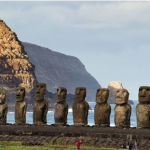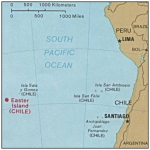By Titos Konstantinos & Paraskevopoulos Vasilis
Easter Island is a Chilean island in the southeastern Pacific Ocean, at the southeasternmost point of the Polynesian Triangle in Oceania. Easter Island is most famous for its nearly 1,000 extant monumental statues, called moai, created by the early Rapa Nui people. In 1995, UNESCO named Easter Island a World Heritage Site, with much of the island protected within Rapa Nui National Park.
The island is about 24.6 km long by 12.3 km at its widest point. Ιts overall shape is triangular. It has an area of 163.6 square kilometres and a maximum elevation of 507 metres above mean sea level. Archipelago Tristan da Cunha in the southern Atlantic competes for the title of the most remote island, lying 2,430 kilometres from Saint Helena island and 2,816 kilometres from the South African coast.
It is believed that Easter Island’s Polynesian inhabitants arrived on Easter Island sometime near 1200 AD! They created a thriving and industrious culture, as evidenced by the island’s numerous enormous stone moai and other artifacts. However, land clearing for cultivation and the introduction of the Polynesian rat led to gradual deforestation. By the time of European arrival in 1722, the island’s population was estimated to be 2,000–3,000. European diseases, Peruvian slave raiding expeditions in the 1860s, and emigration to other islands.





